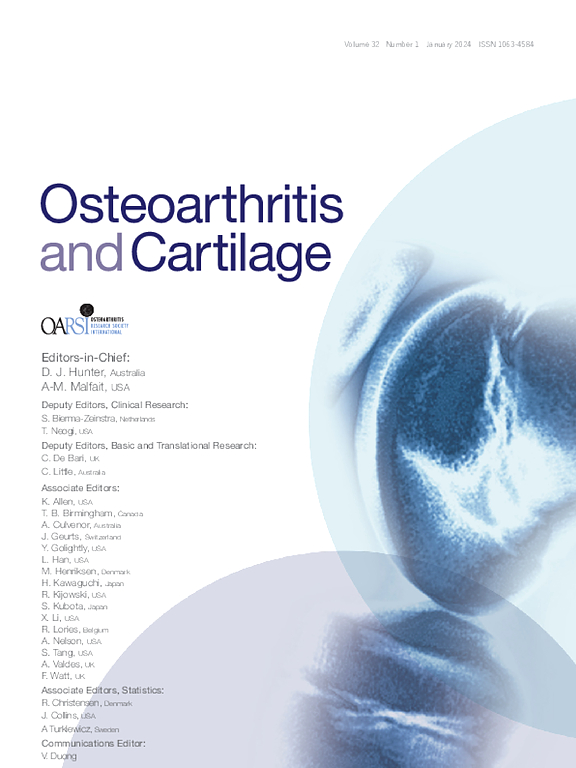People with short symptom duration of knee osteoarthritis benefit more from exercise therapy than people with longer symptom duration: An individual participant data meta-analysis from the OA trial bank
IF 7.2
2区 医学
Q1 ORTHOPEDICS
引用次数: 0
Abstract
Objective
To investigate whether duration of knee symptoms influenced the magnitude of the effect of exercise therapy compared to non-exercise control interventions on pain and physical function in people with knee osteoarthritis (OA).
Method
We undertook an individual participant data (IPD) meta-analysis utilising IPD stored within the OA Trial Bank from randomised controlled trials (RCTs) comparing exercise to non-exercise control interventions among people with knee OA. IPD from RCTs were analysed to determine the treatment effect by considering both study-level and individual-level covariates in the multilevel regression model. To estimate the interaction effect (i.e., treatment x duration of symptoms (dichotomised)), on self-reported pain or physical function (standardised to 0–100 scale), a one-stage multilevel regression model was applied.
Results
We included IPD from 1767 participants with knee OA from 10 RCTs. Significant interaction effects between the study arm and symptom duration (≤1 year vs >1 year, and ≤2 years vs>2 years) were found for short- (∼3 months) (Mean Difference (MD) −3.57, 95%CI −6.76 to −0.38 and −4.12, 95% CI-6.58 to −1.66, respectively) and long-term (∼12 months) pain outcomes (MD −8.33, 95%CI −12.51 to −4.15 and −8.00, 95%CI −11.21 to −4.80, respectively), and long-term function outcomes (MD −5.46, 95%CI −9.22 to −1.70 and −4.56 95%CI −7.33 to-1.80, respectively).
Conclusions
This IPD meta-analysis demonstrated that people with a relatively short symptom duration benefit more from therapeutic exercise than those with a longer symptom duration. Therefore, there seems to be a window of opportunity to target therapeutic exercise in knee OA.
症状持续时间短的膝骨关节炎患者比症状持续时间长的患者更容易从运动疗法中获益:来自 OA 试验库的个体参与者数据荟萃分析。
目的研究膝关节症状持续时间是否会影响运动疗法与非运动对照干预对膝关节骨性关节炎(OA)患者疼痛和身体功能的影响程度:我们利用 OA 试验库(OA Trial Bank)中存储的个人参与者数据(IPD)进行了荟萃分析,这些数据来自随机对照试验(RCT),对膝关节 OA 患者进行了运动与非运动对照干预的比较。通过在多层次回归模型中考虑研究水平和个体水平的协变量,对来自随机对照试验的IPD进行分析,以确定治疗效果。为了估计交互效应(即治疗 x 症状持续时间(二分法))对自我报告疼痛或身体功能(标准化为 0-100 分)的影响,我们采用了单阶段多层次回归模型:我们纳入了来自 10 项研究性临床试验的 1767 名膝关节 OA 患者的 IPD。研究臂和症状持续时间(≤1年 vs >1年,≤2年 vs >2年)之间的显著交互效应在短期(约3个月)(平均差(MD)分别为-3.57,95%CI -6.76至-0.38和-4.12,95%CI-6.58至-1.66)和长期(约3个月)(平均差(MD)分别为-3.57,95%CI -6.76至-0.38和-4.12,95%CI-6.58至-1.66)被发现。66)和长期(约12个月)疼痛结果(MD分别为-8.33,95%CI为-12.51至-4.15和-8.00,95%CI为-11.21至-4.80),以及长期功能结果(MD分别为-5.46,95%CI为-9.22至-1.70和-4.56,95%CI为-7.33至-1.80):这项IPD荟萃分析表明,与症状持续时间较长的患者相比,症状持续时间较短的患者从治疗性运动中获益更多。因此,针对膝关节 OA 的治疗性运动似乎存在机会之窗。
本文章由计算机程序翻译,如有差异,请以英文原文为准。
求助全文
约1分钟内获得全文
求助全文
来源期刊

Osteoarthritis and Cartilage
医学-风湿病学
CiteScore
11.70
自引率
7.10%
发文量
802
审稿时长
52 days
期刊介绍:
Osteoarthritis and Cartilage is the official journal of the Osteoarthritis Research Society International.
It is an international, multidisciplinary journal that disseminates information for the many kinds of specialists and practitioners concerned with osteoarthritis.
 求助内容:
求助内容: 应助结果提醒方式:
应助结果提醒方式:


